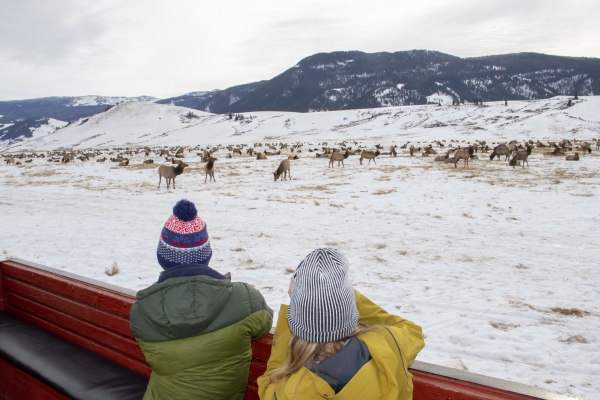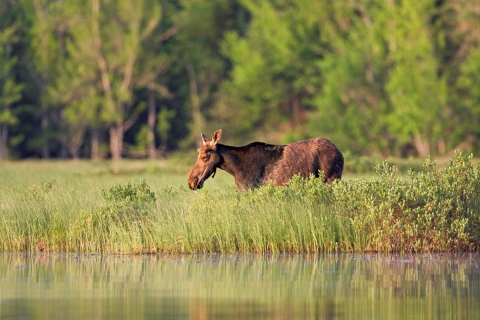
Wildlife Observation Etiquette
The diversity of habitat in the Umbagog area provides ample opportunity to observe wildlife. Wildlife can be fascinating and entertaining to view and photograph, but it is important to remember that human activities can disturb and negatively impact them. Waterfowl and other aquatic birds are particularly vulnerable because they often nest close to the shore, where they can easily be disturbed by boat traffic. If their nests are disturbed too often, the adults may abandon them.
Please take a moment to consider these wildlife viewing guidelines:
- Respect the wildlife and its habitat, as well as its “wildness.”
- If the wildlife is on private property, respect the landowner’s rights.
- For a close look at an animal, use binoculars or a spotting scope; do not approach it. If the animal changes its behavior as a result of your actions, you are too close. When you cause an animal to flee by flying or running away, it uses valuable energy it needs to avoid predators, find food, and successfully reproduce.
- In the spring and early summer, avoid marshy shorelines where birds commonly nest.
- Learn to recognize specific wildlife alarm signals.
- Do not feed wildlife; giving animals handouts is bad for their health.
Moose Watching
Moose are crepuscular animals, which means they are most active and easiest to observe during dawn and dusk. Time of year also effects moose activity. Spring is an excellent time to see moose because they often come to roads to lick the salt left by the melting snow. The fall mating period is another time when moose may be readily seen. During hot summer days, moose often seek the shade of the forest, away from roads. they are more likely to be seen near roads on cloudy summer days. In the winter the opposite holds true: on cold, windy and cloudy days moose tend to seek the protective shelter of the woods.
When looking for moose, it is best to look on the side of the road in muddy, trampled areas. These areas, called wallows, are where moose go to forage on aquatic vegetation and mineral soil. Moose are not always right by roads so it is a good idea to take a pair of binoculars with you.
One of the most important things to remember when viewing moose is that moose are very large and unpredictable animals. It is important to use caution when viewing them on the side of the road because they will not hesitate to walk across the road in front of traffic. When a cow has calves with her she becomes very protective and may charge if approached by a human. Moose are extremely hard to see at times, especially at night. Their dark fur makes them nearly invisible so it is important to use caution when driving at night. Also, please don't stop in the middle of the road to view moose. Pull over to the side to avoid causing a road hazard.
Good Places to see moose in the Umbagog Area
North on Route 16 from Errol
- Just north of the Errol Dam on the left side of the road is a small pond. Sometimes moose can be seen wading in the water and feeding on the aquatic vegetation.
- Further north about .5 miles lies another moose wallow on the left.
- Further north, approximately .5 miles, lies another moose wallow on the left. If you don't see a moose directly on the side of the road, look through the trees. There is a small body of water behind the trees where they like to feed.
- About 1.5 miles north of the Lake Umbagog National Wildlife Headquarters, moose are commonly seen in a long stretch of muddy area on the right. This is on a straight stretch of road and it's easy to pull over for moose viewing.
South on Route 16 out of Errol toward Berlin, NH
- The stretch of road between Errol and the Pontook Reservoir, including the area known as 13-mile woods, is an excellent place to see moose. The 13-mile woods and Pontook areas are adjacent to the Androscoggin River. Moose can often be seen in the swampy and backwater areas of the river.
- A little off of the main road, this is a wonderful place to see moose. Go south on Route 16 toward Berlin. At Milan, turn left to cross the bridge over the Androscoggin River. Upon crossing the bridge, turn right on East River Rd. Go south approximately 1.5 miles to Success Rd, which will be on your left. Turn left on Success Road. It will turn into Success Street and loop back around to East River Road in Milan. Success Road has several wallows where moose are frequently seen.
West on Route 26 toward Colebrook
- Moose may be seen along this stretch, but you need to watch carefully. The woods are thick and moose are often found at the edge of the tree line. The road is curvy and motorists must remember to slow down when approaching curves in order to avoid hitting moose.
- Staying on Route 26 west, just before ascending to Dixville Notch, there is a State of New Hampshire Fish and Game wildlife viewing area on the left.
East on Route 26 toward Upton, Maine
- Approximately 5 miles east of Errol there is a wallow on the left. Moose like to cross the road here, so be prepared.
- Further east on Route 26 is Grafton Notch State Park, ME. Moose can sometimes be seen in this beautiful area. You can also access short, scenic trails from the road.
